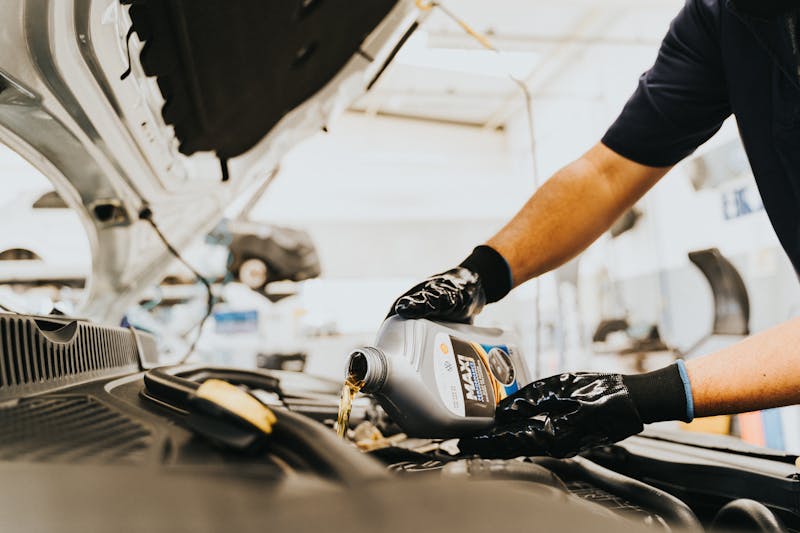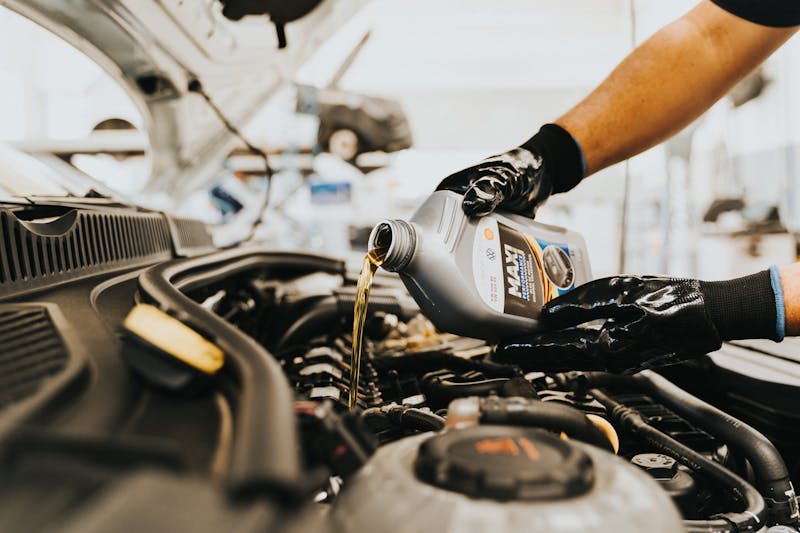
Every car—be it a compact sedan or a burly SUV—relies on fresh, properly lubricating engine oil to run smoothly. Oil serves multiple critical functions: cooling moving parts, reducing friction, capturing debris, and protecting against wear. Over time, oil becomes contaminated with dirt, microscopic metal shards, and combustion by‑products. As oil degrades, it loses viscosity, and its ability to protect the engine declines.
Regular oil changes form the foundation of preventive car maintenance, enhancing engine life, improving fuel efficiency, and minimizing costly repairs. This guide dives deep into the most common signs your car needs an oil change ASAP, empowering you to act early and keep your vehicle running well for years.
What Happens When Your Engine Oil Degrades?
Engine oil doesn’t remain pristine forever. In this section, we’ll explain what happens when oil degrades and why it’s dangerous to delay a change.
Engine oil degrades through exposure to heat, pressure, and combustion by‑products. As it ages, its viscosity may decrease, meaning it becomes thinner, failing to lubricate effectively. Additionally, particles such as carbon, soot, and metal shavings accumulate in the oil, leading to sludge formation. This sludge can clog oil passages, filters, and other components.
The combination of poor lubrication and increased contamination boosts friction, raises operating temperatures, and accelerates engine wear. In extreme cases, oil that’s not changed on time can lead to scuffed bearings, seized pistons, or total engine breakdown. So, understanding the consequences of degraded oil illustrates why “oil change ASAP” isn’t a slogan—it’s a critical maintenance priority.
How Often Should You Really Change Your Oil?
Most owners follow a rule of thumb—3,000 or 5,000 miles—but is that still valid? This section covers modern intervals.
Traditionally, the 3,000‑mile oil change rule was the norm. But thanks to advanced synthetic oils and improved engine design, manufacturers now advise intervals of 7,500 to 10,000 miles, or even up to 15,000 miles under ideal conditions. Factors influencing oil‑change frequency include driving habits, operating environment, oil grade (synthetic vs. conventional), and your car’s model. For example, frequent short trips in stop‑and‑go traffic, hauling heavy loads, or extreme temperatures will accelerate oil degradation. Conversely, consistent highway driving and using high‑quality synthetic oil may extend the interval. Always refer to your vehicle’s owner’s manual for factory‑recommended service guidelines—but watch closely for the warning signs below that may necessitate earlier attention.
How to Check Your Oil Safely at Home
Here’s how to inspect your oil level and condition—two simple checks you can do yourself without special tools.
Checking your car’s oil isn’t complicated. First, ensure the engine is off and cooled down for at least five minutes so the oil settles. Locate the dipstick, pull it out, wipe it clean, then reinsert it fully and pull it out again. Observe the oil level against the ‘add’ and ‘full’ marks—too low means topping up is necessary.
Next, check the color and consistency: healthy oil appears amber or light brown; when dark or black, it may be dirty. Also, rub a bit between your fingers—gritty or thick oil indicates contamination. Finally, sniff for a burnt, acidic odor—another warning sign. If any of these checks raise concern, schedule an oil change ASAP to avoid engine stress.
Car Maintenance Basics: Signs Your Car Needs an Oil Change ASAP
In this section, we’ll go through the most telling signs that your car is overdue for fresh oil—don’t ignore them.
- Unusual engine noise: As oil deteriorates, engine components like lifters and bearings lose adequate lubrication. That leads to ticking, knocking, or metallic sounds, especially noticeable when starting the car after it’s rested.
- Excessive exhaust smoke: Thick, blue, or gray smoke may indicate oil burning within the combustion chamber, often due to degraded oil leaking past piston rings or valve seals.
- Dirty, dark oil: As noted above, oil that’s black or heavily contaminated fails to lubricate properly, increasing heat and wear.
- Oil change or check engine light: Modern vehicles monitor oil condition via sensors. An illuminated oil‑change light or check engine light often signals that no longer meets performance thresholds.
- Reduced fuel economy: Sluggish engine performance from poor lubrication forces your car to work harder, using more fuel.
- Oil smell inside cabin: If you detect an oily smell inside the car, it may suggest oil is leaking onto hot engine parts—either a symptom or contributor to diminishing oil volume and quality.
- High engine temperature: Poor lubrication can increase friction and heat, manifested by elevated temperature gauge readings.
- Mileage past due interval: Even without other signs, passing the manufacturer’s interval (e.g., 5,000 or 7,500 miles) is itself a cause for an oil change, as oils degrade even during idle, low‑speed, or short‑trip usage.
What Should You Do When You Spot These Signs?
Once you observe any warning signs, here’s your action plan for protecting your car’s engine.
- Act promptly: Driving with degraded oil leads to higher wear, so plan an oil change right away.
- Select the right oil: Use the grade recommended in your owner’s manual—semi-synthetic or full synthetic for modern engines offers better protection.
- Replace the oil filter: A clean filter helps maintain oil cleanliness by trapping debris.
- Inspect for leaks or damage: Have a mechanic check for leaks, loose caps, or damaged oil lines.
- Consider an oil flush (if needed): If sludge buildup is severe, a professional flush can help, but should be used cautiously to avoid dislodging particles that might clog passages.
- Record the change: Keep detailed notes of date, mileage, oil type, and filter—it helps you stay on schedule and maintain resale value.
Why Waiting Too Long Costs You More
Putting off an oil change might save money now, but it often leads to much higher costs later. Here’s why.
- Engine wear accelerates: Metal‑on‑metal contact causes faster component degradation.
- Overheating risk increases: Degraded oil doesn’t cool as well, raising temperature and risk of warped parts.
- Oil sludge buildup: Thick deposits clog oil screens, restrict flow, and harm the engine’s longevity.
- Reduced resale value: A poorly documented or maintained oil schedule erodes buyer trust.
- Potential for engine failure: Worst-case scenario: a seized engine or blown head gasket, costing thousands in repairs or total engine replacement.
- Environmental impact: Burning dirty oil emits higher pollutants, harming air quality.
How to Extend Your Oil’s Lifespan Responsibly
Even though oil eventually degrades, smart habits can extend its useful life without compromising engine health.
- Use high‑quality oil and filters: Premium oils degrade more slowly, resist thermal breakdown, and clean better.
- Drive gently during warm-up: Idle the engine briefly (about 30 seconds) before driving off—this allows oil to reach operating temperature and distribute properly.
- Avoid excessive short trips: Cold-start driving without reaching full operating temperature charges the oil with moisture and contaminants. Combine errands or take longer runs regularly to allow a full oil cycle.
- Keep up with other maintenance: Clean air filters and properly inflated tires help your engine work less, preserving oil life.
- Check your oil regularly: Monthly oil checks let you spot problems early, especially color and level changes.
- Monitor dashboard sensors: If your car has an oil-life monitoring system (e.g,. “Oil Life 20%”), use it alongside manual checking—these systems rely on driving factors and oil condition.
How Often Do Manufacturers Recommend Oil Changes?
Understanding factory schedules helps you compare them with your actual driving conditions and habits.
Most manufacturers publish the oil-change intervals in the owner’s manual under “Maintenance Schedule.” Many modern cars now suggest 7,500 to 10,000 miles between oil changes when using synthetic oil, but some high‑end models stretch to 15,000 miles under optimal conditions. For example, Toyota’s newer engines paired with synthetic oil are rated for 10,000‑mile changes; Mercedes and BMW performance engines can stretch to 15,000 miles, but are usually paired with prompt fluid checks. Always verify your make/model/year specifics.
Additionally, if a “severe driving” category applies—like frequent towing, stop‑and‑go city driving, or driving in dusty or extreme climates—you may need to halve those intervals to around 5,000 miles. Your car’s manual is your best baseline—supplement with observations of actual oil condition.
DIY vs. Professional Oil Change: Which Is Right for You?
Some owners enjoy DIY maintenance; others prefer professional service. Let’s weigh the pros and cons.
DIY Oil Change Pros:
- Cost savings: You pay only for parts and oil—no labor charges.
- Control over supplies: You decide the oil grade and filter brand.
- Convenience: Do it at your own schedule from home.
- Learning experience: Great for understanding your car better.
DIY Oil Change Cons:
- Risk of mess or disposal issues: Used oil must be properly recycled.
- Potential mistakes: Forgetting to tighten the drain plug or overfilling the oil leads to issues.
- Physical demands: Requires lifting a car safely with jacks/stands.
Professional Service Pros:
- Speed and convenience: Done quickly with no fuss.
- Proper disposal: They handle used oil responsibly.
- Inspection included: Many shops inspect belts, hoses, and filters during service.
- Peace of mind: Warranty‑safe procedures and documented service.
Professional Service Cons:
- Higher cost: Includes labor markup.
- Limited control: You rely on the shop’s choice of oil/filter unless specified.
Ultimately, if you’re comfortable under the hood and follow safety/cleanup steps, DIY saves money. Otherwise, professionals ensure convenience and added checks.
FAQs About Oil Changes Every Car Owner Should Know
Here are some common questions (plus clear, expert answers) to guide oil‑change decisions.
Q: Can I drive after noticing an oil‑change warning light?
A: If the light indicates oil condition—not low oil level—you can drive short distances (e.g., to a service station). But it’s best to stop soon and change immediately; continued driving damages the engine quickly.
Q: Is it okay to just top off oil if it’s low?
A: Topping off can help if the oil is just low, but it doesn’t fix degraded oil quality. You still need a full oil and filter change if the oil looks dark, gritty, or smells burned.
Q: Do different oil brands matter?
A: Yes—reputable brands meet API or ACEA specifications, ensuring proper performance under heat and wear. Avoid “generic” or unbranded oil that may not protect your engine as well.
Q: Synthetic vs. conventional oil—which is better?
A: Synthetic oil offers better thermal stability, less evaporation, and superior viscosity across temperatures. It protects longer and performs better under high-stress conditions, though it costs more. Many modern engines now require or recommend synthetic. Check your manual.
Q: What if I miss a scheduled oil change?
A: Missing one by a few hundred miles isn’t catastrophic, but if you go thousands overdue, that’s a risk. Get back on schedule ASAP, possibly with an oil flush if recommended by a mechanic.
Recap: Key Signs You Shouldn’t Ignore
Just to reinforce the most important warning signs that demand prompt oil change action.
- Noisy engine operation (ticking, knocking)
- Thick, colored exhaust smoke
- Dark, gritty, or burnt‑smelling oil
- Oil‑change, check‑engine, or oil‑pressure warning lights
- Declining fuel economy
- Burning oil smell inside the vehicle
- Higher engine temperature readings
- Mileage exceeding the manufacturer‑recommended interval
Ignoring these can lead to degraded performance, higher fuel costs, costly repairs, or even complete engine failure.
Closing Thoughts: Prioritize Oil Changes for Longevity
Oil changes aren’t a glamorous task, but they are the most fundamental defense against engine wear. Whether you drive daily, take long trips occasionally, or use your vehicle for heavy‑duty work, fresh oil ensures components move smoothly, combustion runs cleaner, and your engine stays healthier. Watching for signs your car needs an oil change ASAP—from unusual sounds to dark oil—is more than routine: it’s smart maintenance that saves you time, money, and stress later. Stick to recommended intervals, inspect your oil regularly, and don’t fall into the “I’ll wait one more week” trap. Your car—and your wallet—will thank you.




